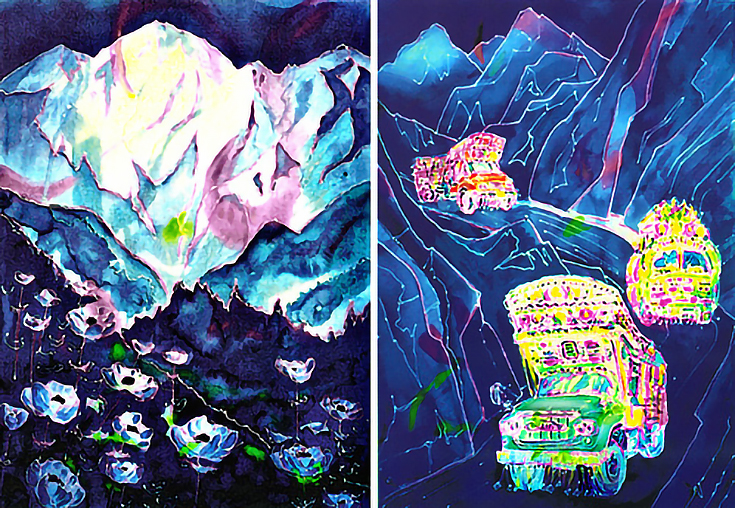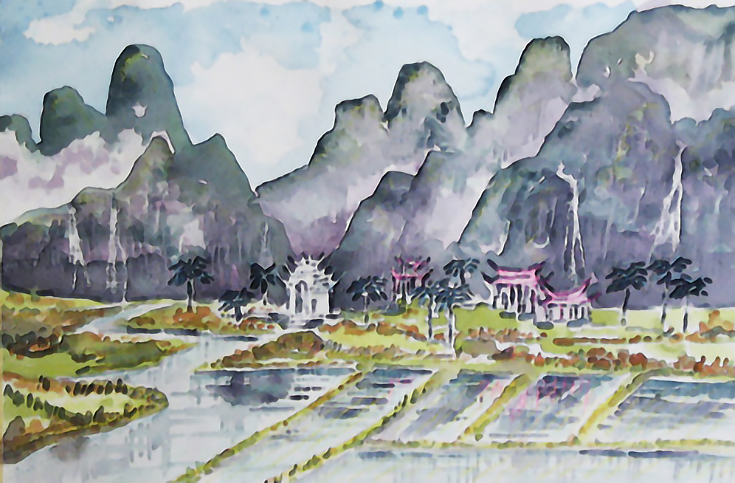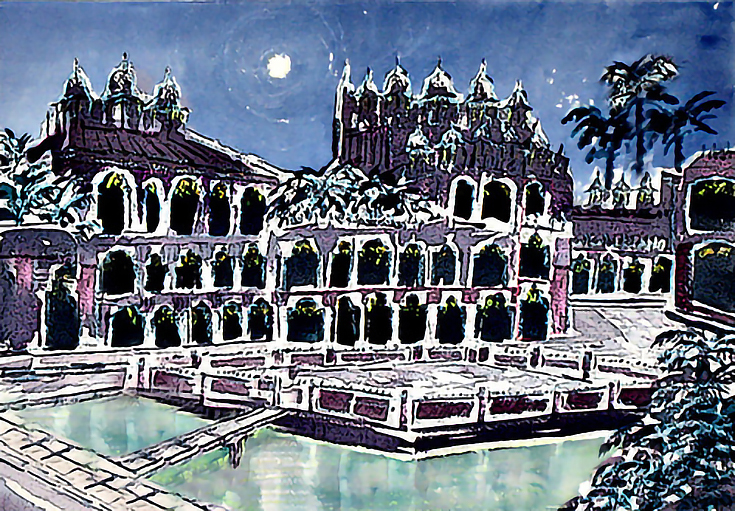Watercolour painting is only “extreme” under certain circumstances—for me, extreme watercolour painting must be done on location, in a foreign country, in a place that you can only reach by taxi.
Here are my adventures from three countries, beginning with Pakistan.
Watercolour painting in Pakistan
To my surprise, my husband agreed to accompany me on a painting “trek” in the mountains of Pakistan. We’d drawn up a fairly tight schedule: a flight to Islamabad, with side trips up to Gilgit in the Himalayas and Chitral in the Hindu Kush, to see some of the highest mountains in the world.
The man who checked us onto the Islamabad flight at the Dubai airport was most helpful and particularly pleased when we mentioned the mountains—his part of the country as it turned out. In his enthusiasm, however, he apparently overestimated our age and said we really must plan to stay at the Pearl Continental Hotel—five stars!—at Bhurban in the Murree Hills.
Without being too scathing about it, I allowed that we might try something a little more challenging. Then I shouldered my painting pack as effortlessly as possible and, with a friendly wave, marched carefully up the boarding stairs.
Our carefully planned schedule began to unravel at the Islamabad airport when we arrived at the check-in for the flight to Gilgit. We thought we got there early enough to get on the flight, having arrived two hours before take-off, but soon learned that the other folks there (enough for about one and a half planeload’s worth) had arrived on average two days before take-off time.
After a side trip to the booking office in nearby Rawalpindi, we arrived back in the airport only to find that our chosen flight had been canceled. We decided to switch our flight to the next day and phoned the Pearl Continental—five stars!—in Bhurban, which we were told was a three-hour taxi-drive away.
About one hour into the precipitous drive, we decided against making the trip back to the airport each day to check on flights—if we ever made it to the top, we’d be up there for the duration of our stay.
Besides traversing several washouts—one of which was still underway—we had to get past the most beautifully decorated fleet of trucks in the world. These trucks were huge, slow, and ever so paintable. Each time we passed a really spectacular one, we had to stop so I could take its picture as it inched past us. Then, of course, we were behind it again.
Adding to all this excitement was the frequent arrival of equally huge and beautiful trucks coming down on the return trip to Islamabad, at speeds approaching free-fall.
But eventually, the extreme painting trip worked out, and so did the pictures.
Painting in Vietnam
My next extreme painting adventure was in Vietnam. Unlike Pakistan where woman cannot travel unaccompanied, I was on my own. When I landed in Hanoi, I selected one of the airport taxi drivers and showed him the list of eleven places I wanted to be taken to. My objective was to see the lakes of Hanoi, seascapes of the Gulf of Tonkin, and the mountains.
The driver determined this was going to take several hours, ascertained that I would pay in American dollars (a very reasonable number of them, I should mention) and off we went.
Everywhere one goes in Vietnam, north or south, city or country, driving or walking, requires the negotiation of mixed flows of bicycles, motorcycles, cars and buses. Really mixed flows. At first I was terrified. . . cyclists in Vietnam are not expected to confine themselves to slow lanes, and the motor vehicles (some of which have all the acceleration of a well-oiled grocery cart) are not about to lose precious momentum by slowing down unnecessarily.
When I calmed down a little, I realized that as long as we didn’t do anything the rest of them couldn’t possibly anticipate—like come to a stop!—we’d eventually get where we were going. We were simply woven into the pattern.
People have said I captured the tranquility of the landscape in my paintings, which is pretty amazing, since there wasn’t much to capture!
Extreme painting in India
And then there’s India. . . a place where the signs on the backs of the big trucks all say “Please Honk.” I am not making this up—there are reason for the signs!
You see, nobody has side mirrors. With four or five lanes of traffic on every two-lane road, there’s simply no room for such whimsy.
I grew quite fond of those signs. As long as I was staring at one, the accident I expected at any second would be a simple rear-ender.
I got firsthand experience in an accident, too, near the Red Fort in Delhi. None of the four participating vehicles (of which my own taxi was one) were going very fast. We all slowed right down while the grinding and bashing was going on.
But nobody actually stopped, either. . .
After that I began to notice that everyone had scrapes and grooves on most of their doors and fenders. My driver confirmed my suspicion that it was not common practice to have these things repaired right away. . . after all, a few strategic gouges make an important statement about the likelihood of your yielding the right-of-way.
Also, in India they drive on the left, where I have never really felt comfortable. Despite that, most of the time we were on the RIGHT, because my driver was passing everything on the road—camel caravans, bicycles, still-smoldering wrecks, cattle, “Please Honk” trucks, paan-encrusted buses, jewelry sellers, small restaurants, vehicles being repaired (protected by rows of boulders rolled onto the road), terrified tourists, plus about a million of the regular things you’d expect to find on a highway.
After a scary day of taxiing around Delhi, we set out the next morning for the Taj Mahal. It is said that no matter how much you may have heard about this serene and perfect place, it will not disappoint you. And it’s true. We left as the rising full moon made the most of its opalescent splendor.
For reasons that escape me, I had made a hotel reservation for the night in Jaipur, about 260 kilometers away. We made a brief stop at “the Emperor’s Dream City,” Fatehpur Sikri.
(Did I relax and paint this wondrous place? Not a chance! I was barely able to do one extreme location sketch.)
After Fatehpur Sikri, we negotiated the remaining distance to Jaipur, arriving a little after midnight. I’m pretty sure that less than half of the other users of the road had lights. . . and I’ve never been so scared in my life.
Extreme watercolouring certainly has it’s ups and downs, but the results (and the adventure) is what makes it all worth it!
For more watercolour paintings from Charlene Brown, please visit her art blog.
This post may contain affiliate links.



